9 cars with f1 engines [+6 other f1 inspired cars]
We've already answered the question "are F1 cars street legal" - but what if I told you that the high-octane power of Formula 1 cars isn’t only for the racing track but also for the open road?
The beastly automobiles I’ll be talking about in this article either have an F1 engine under their hoods or are F1-inspired cars. What they all have in common is ungodly performance thanks to their superior pedigree.
They’re all fast. Very fast.
Without further ado, here are the best cars with F1 engines!
1. Mercedes-AMG Project ONE
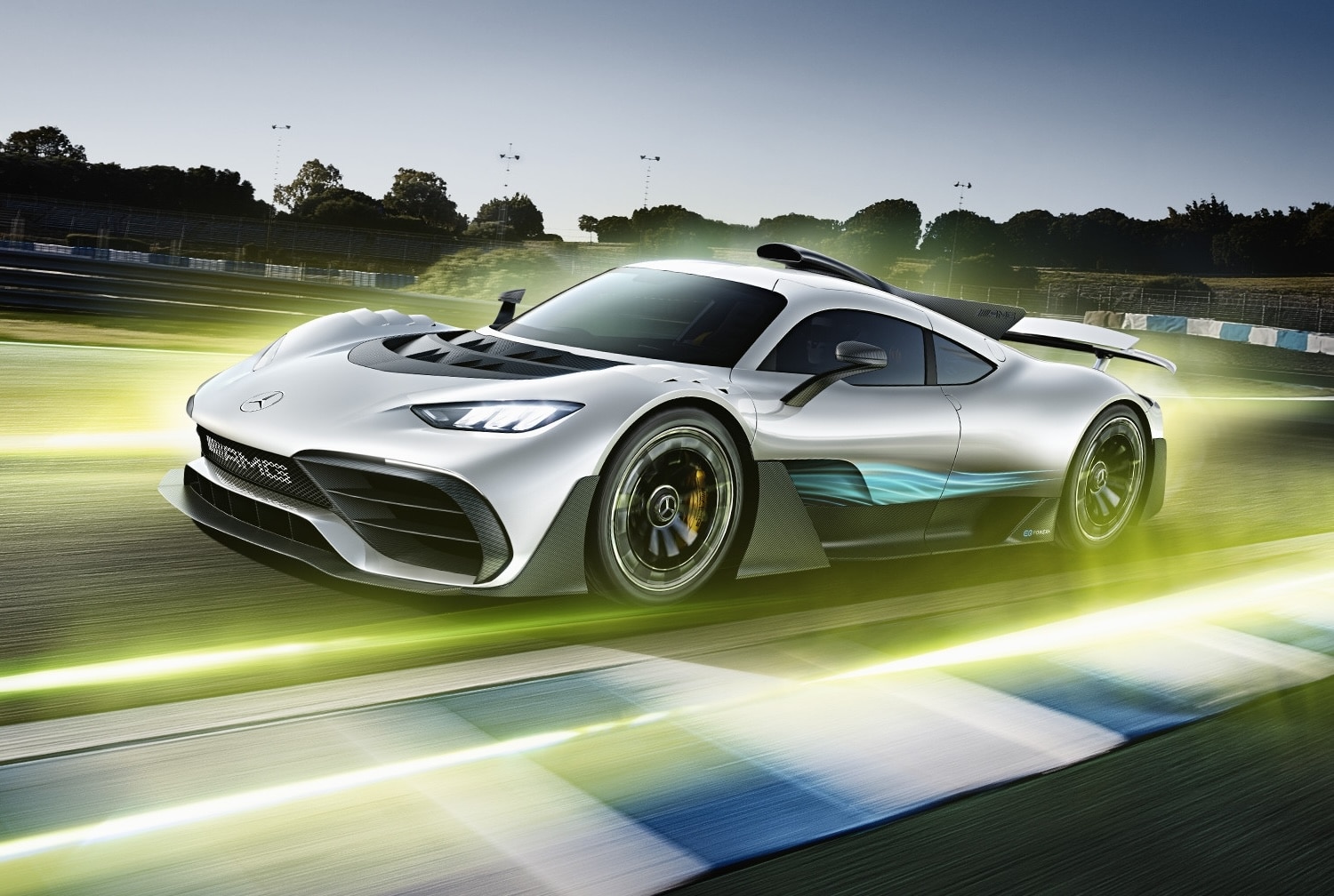
Hands down, the best Formula 1-inspired street car in the world is the Mercedes-AMG Project ONE. It uses a current F1 engine, the 1.6-litre turbocharged V-6, fitted with four electric motors and has a maximum of 11,000 RPM instead of the 15,000 RPM for F1 engines.
Hyper-performance is the name of the game here, which is why even Lewis Hamilton owns one. Let’s look at the technical data straight from Mercedes’s website:
| Rear-Wheel Drive | 1-6-litre V6 with direct injection, four valves per cylinder, four overhead camshafts and an electrically boosted single turbocharger, and an electric motor connected to the crankshaft |
| Displacement | 1,600 cc |
| Rear-Wheel Drive Output | >500 kW |
| Front-Wheel Drive Output | x 120 kW |
| System Output | >740 kW (> 1,000 hp) |
| Electric Range | 25 km |
| Drive System | Variable AMG Performance 4MATIC+ all-wheel drive using a hybrid-drive rear axle, an electrically-driven front axle, and toque vectoring |
| Transmission | Automated AMG SPEEDSHIFT 8-speed manual transmission |
| Acceleration 0-124 mph / 200 km/h | >6 sec |
| Top Speed | >217 mph (350 km/h) |
Mercedes itself boasts that “The two-seater Mercedes-AMG Project ONE will transfer the latest and most efficient Formula 1 hybrid almost one to one from the track to the street for the first time.”
It’s easy to see why. The Mercedes AMG ONE engine can produce an excess of 1,000 hp with a max speed of 217 mph (350 km/h). It’s not for the faint of heart but it’s the closest thing you’ll get to an Formula One car on the open road.
It might not be the most powerful engine, but it sure comes close.
Worthy Mention: Mercedes 300 SLR
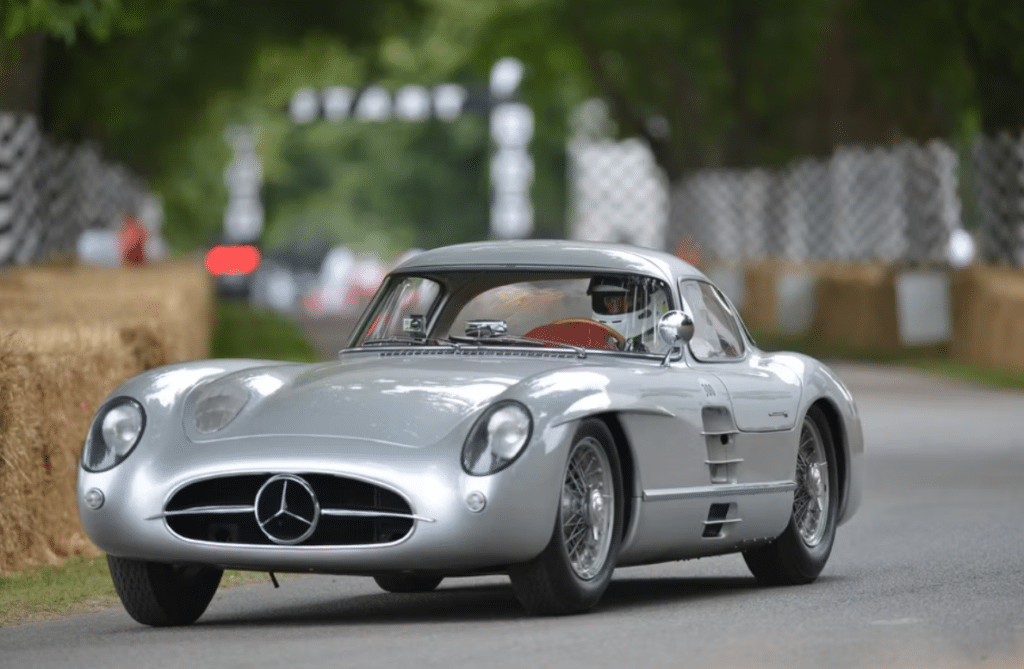
Another Mercedes supercar worth mentioning is the 300 SLR, which was inspired by the W 196 R “Silver Arrows” Formula One car that debuted in 1954. It uses a 3.0-litre naturally-aspirated inline-eight engine that produces 310 hp.
The Mercedes 300 SLR is also the most expensive car in the world, with one of the two models being sold for $143 million at a private auction in Stuttgart in May 2022.
2. Aston Martin Valkyrie
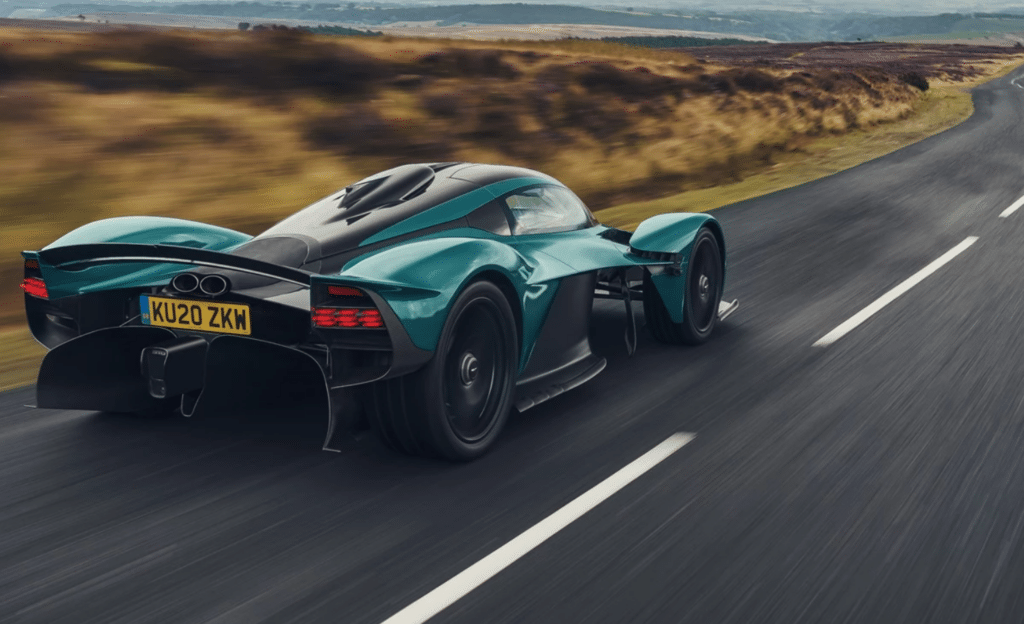
The Aston Martin Valkyrie is a technological marvel, from its V12 engine that revs up to 11,100 RPM, to its 3.3g lateral g-force, extreme aerodynamism, and 40-micron-thick aluminum wings for reduced weight.
The car was made with F1 technology in mind, and just like the Mercedes-AMG Project ONE, it’s a hyper-car through and through.
Here’s the spec list:
| Layout | Rear Mid-Engine, Rear-Wheel-Drive |
| Engine | 6.5-litre Aston Martin-Cosworth RA Naturally-Aspirated V12 with KERS assistance |
| Electric Motor | 160 hp (119 kW; 162 PS) Integral Powertrain Ltd. Permanent Magnet Synchronous Electric Motor |
| Power Output | 1,139 hp (849 kW; 1,155 PS) |
| Transmission | 7-Speed Ricardo Transmission Single-Clutch Automated Manual |
| Drivetrain | Full Hybrid |
| Maximum RPM | 11,100 RPM |
| Acceleration 0 – 62 mph (100 km/h) | 2.6 seconds |
Its racetrack counterpart is the Valkyrie AMR Pro, which was first introduced during the 2018 Geneva Motor Show. It uses the exact same engine, with slight modifications necessary for track conditions. Its estimated RPM is between 10,500-11,100.
So, in all intents and purposes, the Aston Martin Valkyrie is an F1 race car with the maximum specs possible to still be road legal.
It even has a KERS energy recovery system for kinetic energy regeneration when braking. Just like the ones installed on F1 cars.
3. McLaren F1

Nothing is as iconic in the world of supercars as the McLaren F1. Made in 1992, the car went on to smash multiple performance records, including:
- Top speed: 243 mph (391 km/h)
- Best power-to-weight ratio
- Fastest car at the time, reaching 231 mph (372 km/h) with a rev limiter and 242 mph (391 km/h) without a rev limiter
The engine powering this beast is a 6.1-litre BMW V12 engine with 48 valves and a quad cam. With variable valve timing too.
It can pull 627 bhp and can accelerate to 62 mph (100 km/h) in around 3.2 - 3.3 seconds. Its maximum RPM is 7,500, which puts many modern cares to shame.
The McLaren F1 was birthed from a simple idea – What if we created the fastest and most performant road car while sparing no expenses?
Gordon Murray, who was the Technical Director and car designer for the McLaren F1 team, made no compromises when designing the F1.
Take a look below at the car’s technical specs:
| Engine | BMW S70/2, 6.1-litre 48 valve V-12 with Aluminum Block and Heads |
| Maximum Horsepower | 627 bhp |
| Engine Displacement | 370 cubic inches, 6,064 cc |
| Compression Rate | 10.5:1 |
| Engine Control System | Bosch Motronic with Port Fuel Injection |
| Maximum RPM (Redline) | 7,500 |
| Valve Gear | Chain-Driven Double Overhead Cams, 4 Valves per Cylinder, Hydraulic Lifters, Variable Intake Timing |
There’s a reason why the McLaren F1 has stood the test of time as a legendary road supercar.
Worthy Mention: McLaren P1
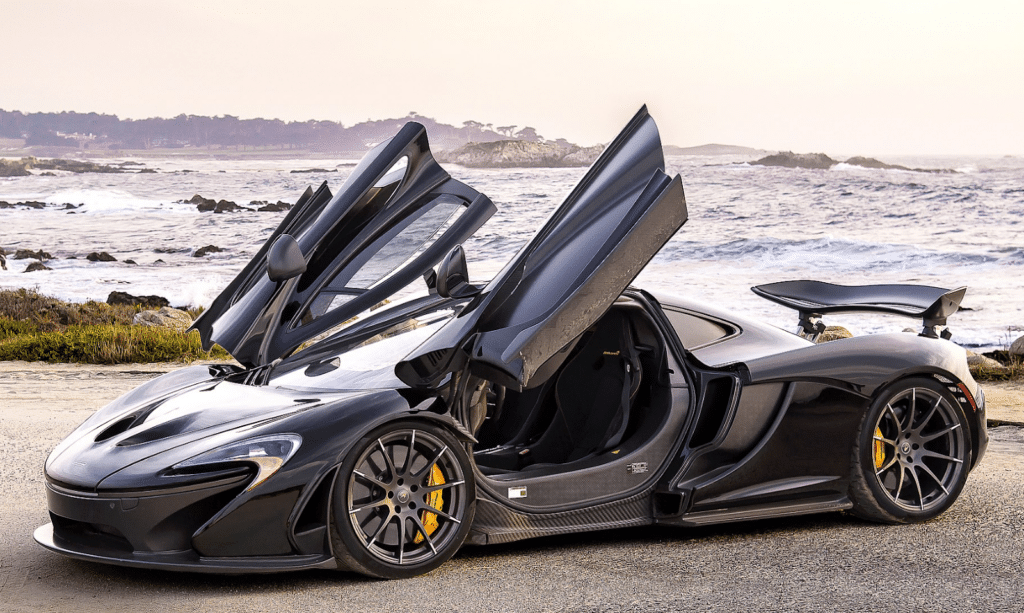
The McLaren P1 is also an excellent reflection of what makes McLaren great – bleeding-edge automotive technology, blindingly fast speeds, and peak performance.
The P1’s top speed is 217 mph (350 km/h), with a maximum torque of 900 Nm, 903bhp (916PS) and a pristine 3.8-litre V8 engine that roars impeccably on the road. The engine also caps at 3,799 cc.
Still, nothing can beat the iconic McLaren F1!
4. Ferrari LaFerrari
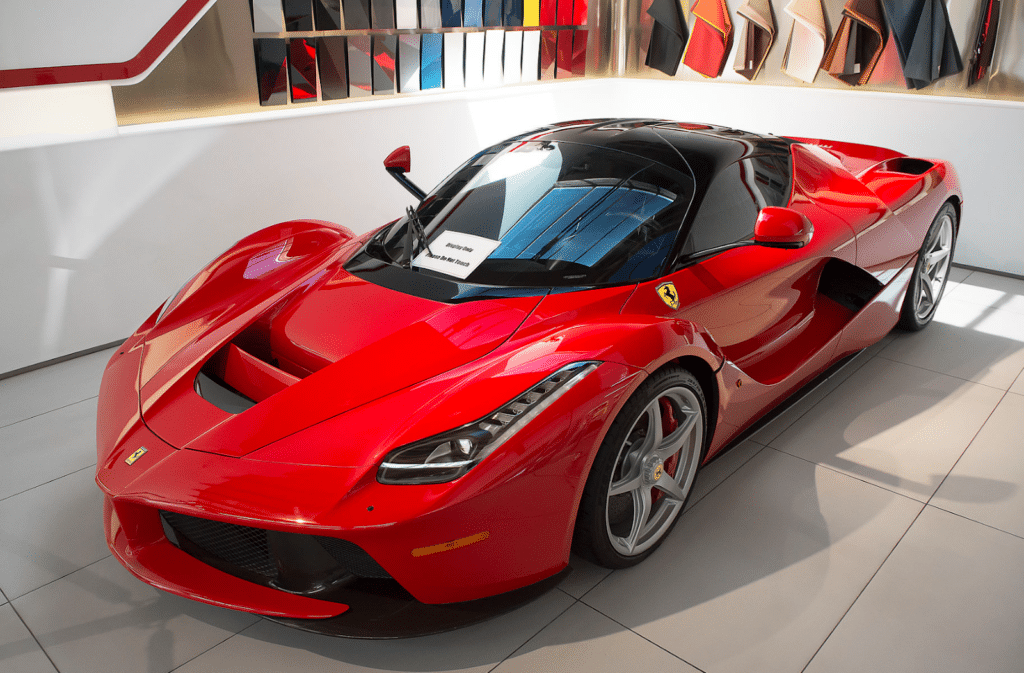
LaFerrari is the first production car from Ferrari equipped with an F1-derived hybrid engine system.
It brings together the V12, 800CV at 9,000 RPM engine with an electric motor that produces 163 PS.
This match-up produces a max speed of 217 mph (350 km/h) at around 963 CV, and it reaches 0-124 mph (0-200 km/h) in 6.9 seconds.
The engine spins at a maximum of 9,250 RPM, which does two things:
- Offers unparalleled on-the-road performance and comfort
- Produces that unmistakable roaring sound of a classic Ferrari V12 engine
In Ferrari’s own words, the engine is “The most powerful naturally-aspirated engine ever used on a Ferrari road car.” Even Rory Byrne would be proud of it!
Here’s the spec list taken from the manufacturer’s website:
| Maximum Torque | >900 Nm |
| Maximum Revs | 9,250 RPM |
| Electric motor output | 120 kW |
| Maximum Speed | >217 mph (350 km/h) |
| Acceleration 0-124 mph (200 km/h) | <7 sec |
| Gearbox | 7-Speed DCT |
| Engine Displacement | 6,262 cc |
| V12 Maximum Power | 800 PS at around 9,000 RPM |
The F1 is the brainchild of Formula 1 and GT engineering, the most efficient and highest-performing Ferrari F1 car ever built.
Everything is designed with performance in mind, from the HY-KERS system that perfectly blends the V12 and electronic motors together, to the F1 dual-clutch gearbox, carbon fiber chassis, carbon ceramic brakes, and the intake system that maximizes the intake volume efficiency.
Worthy Mention: Ferrari F50

The Ferrari F50 has an F130B 4.7-litre naturally aspirated V-12 engine with a 512-hp total output. With its six-speed manual transmission, the F50 could hit 60 mph (97 km/h) in around 3.8 seconds.
Only 349 F50 cars were ever created, and over the years, the F1 car has gained increasing traction with automobile collectors. It’s still one of the best F1-powered road cars Ferrari has ever designed.
5. Porsche Carrera GT
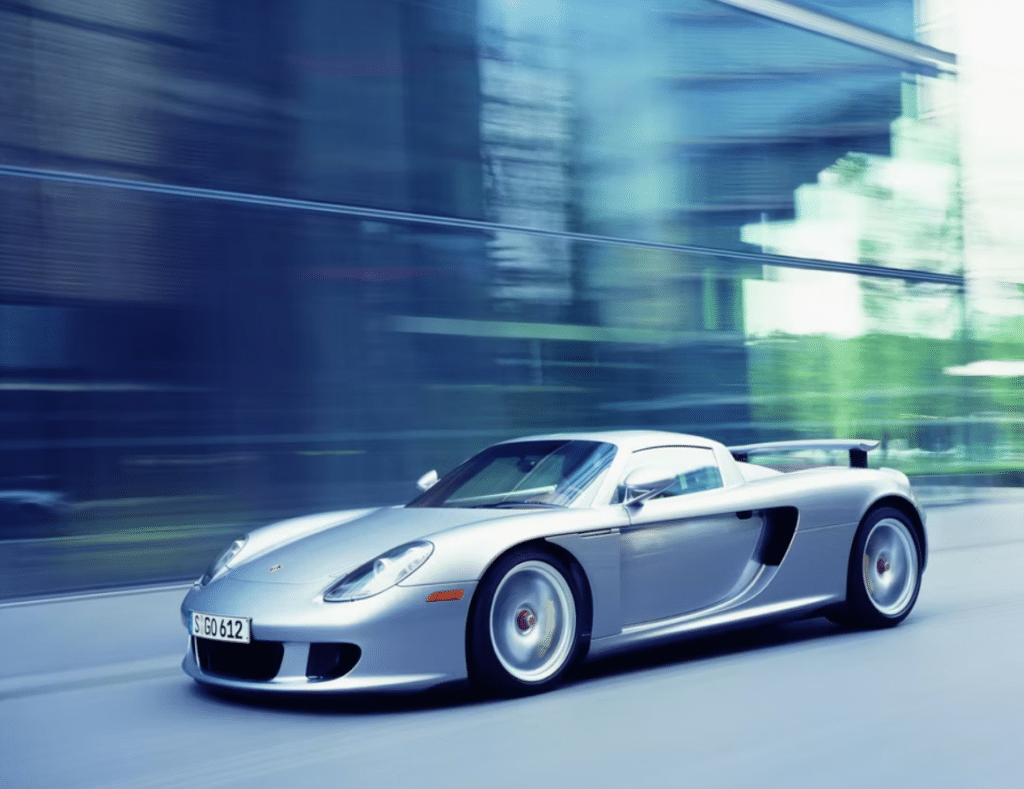
A supercar list wouldn’t be complete without the Porsche Carrera GT, one of the last purely-mechanical supercars before the advent of more digitized automobiles.
The Porsche Carrera GT had a 5.7-litre V-10 engine block inspired by the 5.5-litre V-10 that Porsche developed for Footwork, the British F1 racing team.
It’s a naturally-aspirated engine that pulls 450 kW/612 PS at around 8,000 RPM and 590 Nm at around 5,750 RPM.
When taken to the extreme, the Carrera GT has a maximum speed of over 205 mph (330 km/h) and it hits 62 mph (100 km/h) in 3.57 seconds.
Here’s the spec list:
| Engine | 5.7-litre V-10 Engine, Aluminum, Water-Cooled with Dry Sump Lubrication |
| Valvetrain | Chain-Driven DOHC, 4 Valves per Cylinder, Variable Valve Timing in Intake Camshafts |
| Engine Displacement | 5,733 cc |
| Power | 605 bhp at around 8,000 RPM |
| Torque | 435 ft lbs at around 5,750 RPM |
| Weight-to-Power Ratio | 5.31 lb/hp |
| Maximum RPM | 8,400 |
| Acceleration 0-62 mph (100 km/h) | 3.57 seconds |
| Top Speed | 207 mph (334 km/h) |
From its premium-quality soft leather to the beech-wood gear shift knob, the huge air intake, carbon underbody, and rear diffuser, everything about the Carrera GT screams functionality and comfort.
6. BMW E60/E61 M5 & E63/E64 M6

The E60 and E61 M5 are the first production sedans to use V10 engines in the world. BMW made a statement with those two models – that they would take on-road automobile performance to the next level.
The E63 and E64 M6 used almost the same mechanical parts, down to the same S85 V10 engine and SMG-III automated manual gearbox as the M5 variants. The only difference is that the M6s came as a coupé (E63) and convertible (E64).
Here’s a technical overview for the M5 E60 & E61:
- 5.0-litre S85 Uneven Firing 90 Degrees V10 engine
- Acceleration 0 – 62 mph (100 km/h) in 4.7 seconds
- Top speed of 155 mph (250 km/h) (189 mph / 305 km/h with the M-driver’s package)
- 7-speed SMG-III transmission (6-speed manual in North America only)
- 373 kW (500 hp and 507 PS) power output at about 7,750 RPM
- 520 Nm of torque at about 6,100 RPM
And here’s more about the M6 E63 & E64:
- Same engine as the M5
- Same transmission as the M5
- Two engine power modes: The “P400” with a power output of 394 hp (294 kW) and the “P500” with an output of 500 hp (373 kW) for even more power
- Acceleration 0-62 mph (100 km/h) in 4.6 seconds, one millisecond faster than the M5 models
- Top speed identical to the M5
The M5 and M6 BMW models were the world’s first F1-powered sedans. Their V-10 engines offered crisp responses, excellent acceleration, and a lot of horsepower to play with.
Worthy Mention: BMW 02 Series

The BMW 02 Series, which includes the 1502, 1602, 1802, and 2002 models, all had an M10 engine. This particular engine was the precursor to the M12 and M13, which was the standard BMW’s Formula One engine.
The original M10 engines were quite weak, with a 105 PS at 77kW with a maximum 104 hp at 6,000 RPM. The M12/M13 engines, on the other hand, produced 11,500 RPM and about 740-900 bhp.
7. Alfa Romeo 33 Stradale
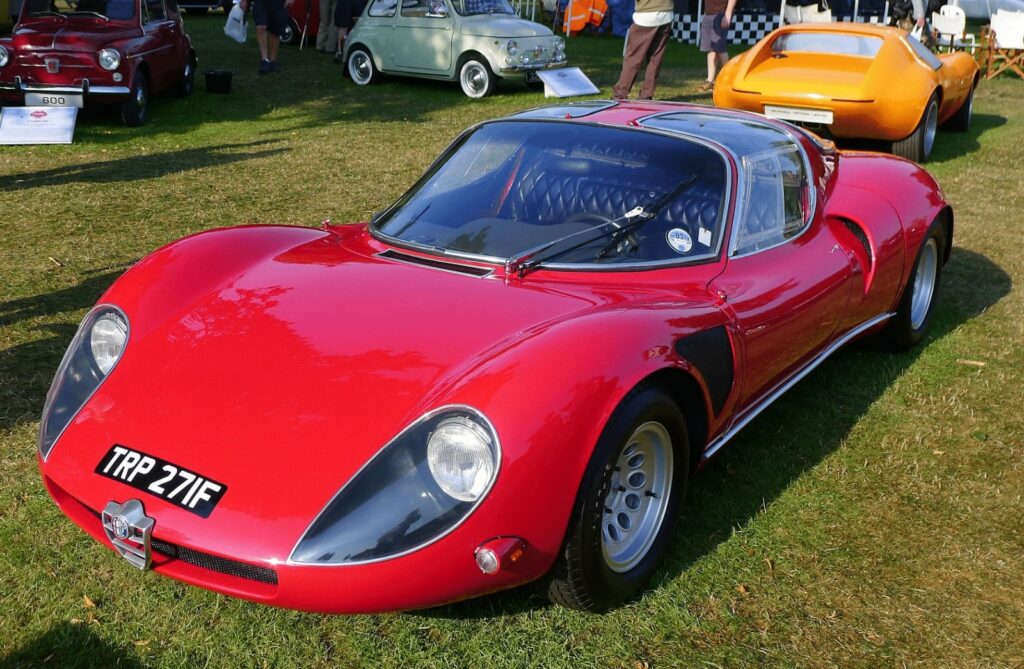
The Alfa Romeo 33 Stradale has excellent racing pedigree since it was inspired by the Autodelta Alfa Romeo Tip 33 F1 car. That one debuted in 1967 at the Paris Salon de L’Auto in F1.
The 33 Stradale has a 2.0-litre V-8 engine with a displacement of 1,995 cc that can easily push 227 hp (169 kW) at around 8,800 RPM.
This engine was a leap forward for Alfa Romeo, being specifically designed with racing capabilities in mind. The flat plane crankshaft and the six-speed transaxle are proof enough of the car’s racing heritage.
Here’s the spec list:
| Engine | 2.0-litre V-8 DOHC |
| Engine Displacement | 1.995 cc |
| Power | 227 bhp (169 kW and 230 PS at around 8,800 RPM) |
| Torque | 206 Nm at around 7,000 RPM |
| Top Speed | 161 mph (260 km/h) |
| Acceleration 0-62 mph (100 km/h) | <6 seconds |
| Gearbox | Six-Speed |
The Alfa Romeo 33 Stradale was also the most expensive F1 car for public use at the time, going at around $17,000 USD. For comparison, cars usually cost around $2,800 back in 1968.
The main idea behind the 33 Stradale was for Alfa Romeo to start producing racing-inspired road legal cars. They already had a strong presence in Formula 1, having won two World Divers’ Championships with the Alfetta (1950 and 1951).
The next step was taking that performance to the street, and that was what they did with the 33 Stradale.
Worthy Mention: Alfa Romeo Montreal
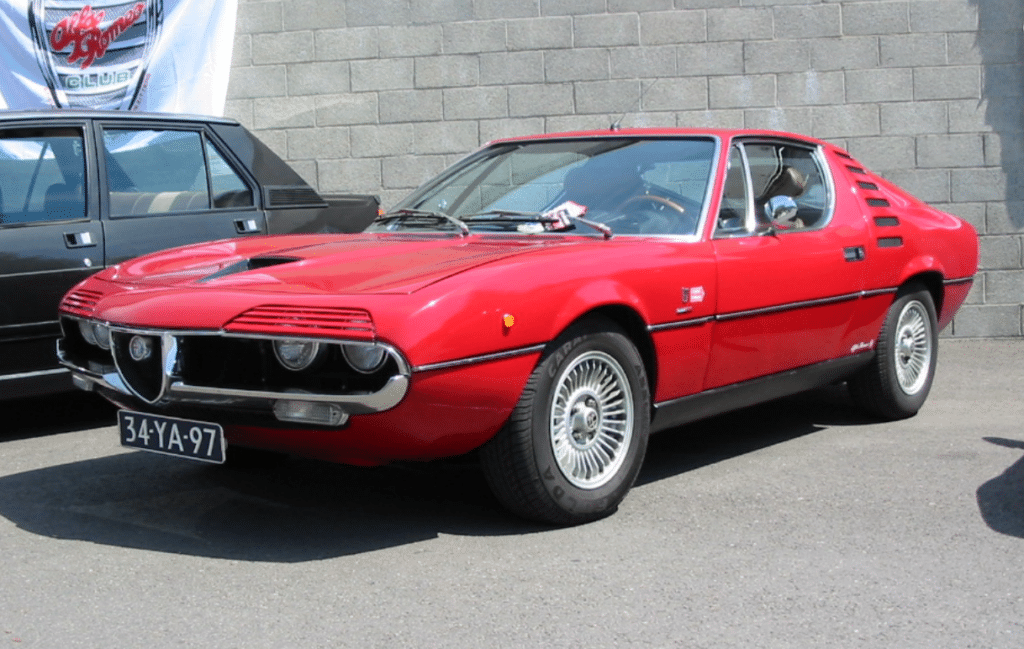
An honorary mention is the Alfa Romeo Montreal, which was derived from the 33 Stradale and the Tipo 33. So, it still had F1 racing roots down to its core.
The engine is a Montreal V8, oversquare 90°, DOHC, with 4 valves per every cylinder and SPICA fuel injection. The displacement is around 2,593 cc (higher than the 33 Stradale), with a power of 197 hp (200 PS) at around 6,500 RPM.
Unlike the 33 Stradale, though, the Montreal gave up on the flat-plane crankshaft and chose the cross-plane crankshaft.
8. Tramontana R

Aside from the Aston Martin Valkyrie, the Tramontana R is the closest car to an F1 racer, visually speaking. It looks like something fresh from the track.
With its 6-speed sequential gearbox and the rear-wheel drive, it can reach speeds of over 202 mph (325 km/h) easily.
It also does 62 mph (100 km/h) in approximately 3.6 seconds, which is up there with the rest of the F1-inspired supercars. The F1 car is still manufactured today, though only 12 per year are made.
Take a look at the specs sheet:
| Engine | Mercedes-Benz 5.5-litre OHC M285 Bi-Turbocharged V-12 |
| Engine Power | 710 hp (530 kW at around 720 PS) |
| Top speed | 202 mph (325 km/h) |
| Acceleration 0-62 mph (100 km/h) | 3.6 seconds |
| Transmission | 6-Speed Sequential |
| Maximum RPM | 5,250 RPM |
| Engine Displacement | 5,513 cc |
| Torque | 1,100 Nm |
Every single Tramontana Car, including the R model, is custom-made as per the client’s specifications. The idea behind it is to provide the best racing experience on the open road. That’s where the V-12 turbocharged engine comes into play.
The entire design of the car screams of aerodynamism, precision-infused elements, and performance over everything else.
9. Yamaha OX99-11
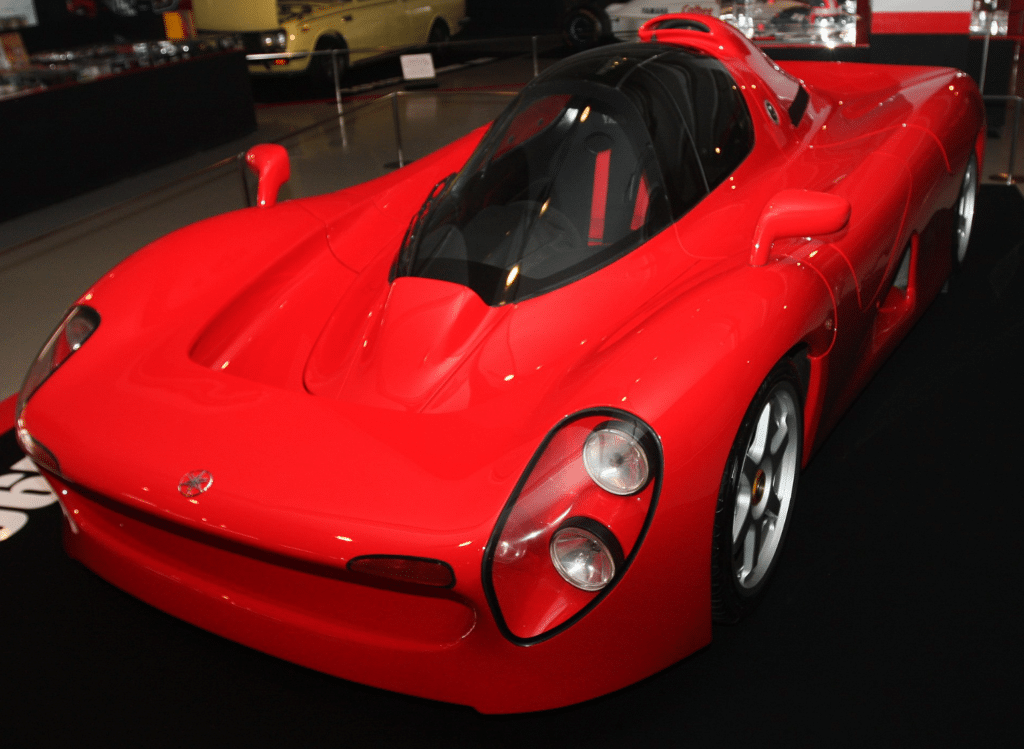
Meet the supercar that never sold, the Yamaha OX99-11. Built in 1992 as a single-seater and then modified to a two-seater, the supercar had a 3.5-litre OX99 V-12 engine originally devised for Formula One.
Money was no issue, so the manufacturer went all in. The car had 400 maximum hp (300 kW) at around 10,000 RPM, a cockpit roof, and some of the smoothest curves you’ve seen.
Let’s see the spec list, though:
| Engine | 3.5-litre OX99 70° V12 400 hp (300 kW) at around 10,000 RPM |
| Maximum Speed | 200 mph (322 km/h) |
| Engine Type | Naturally Aspirated 12-Cylinder Engine |
| Maximum Power | 395 bhp (400 PS and 294 kW) |
| Maximum RPM | 10,000 RPM |
| Engine Displacement | 3,498 cc |
| Transmission | 6-Speed Manual |
The OX99 engine used in this car had been provided to the Motor Racing Developments (Brabham) F1 racing team too.
Yamaha then took this engine and arranged for the OX99-11 car to be made by a German carmaker. Several iterations of the car were needed until Yamaha was satisfied with the end product.
However, the price tag was expected to be around $800,000 USD at the time, and Yamaha delayed the project until eventually cancelling it in 1994. All in all, only three OX99-11 hyper-cars were ever made and none were sold.
Conclusion
The supercar industry made history with many of these cars, some of which are still legendary to this day.
There’s no doubt that Formula One’s influence led to some of the greatest open-road automotive advances in history. Both the McLaren F1 and the Porsche Carrera GT played an important role in defining the industry as a whole.
In the end, track racing and open-road driving have become intertwined ever since, and we surely love what came of it.
Stick around for more fascinating pieces in the world of F1 racing!